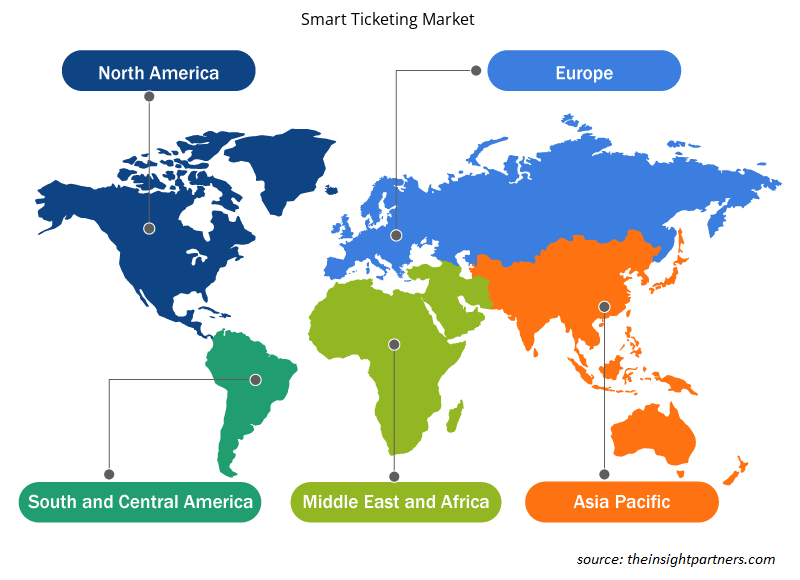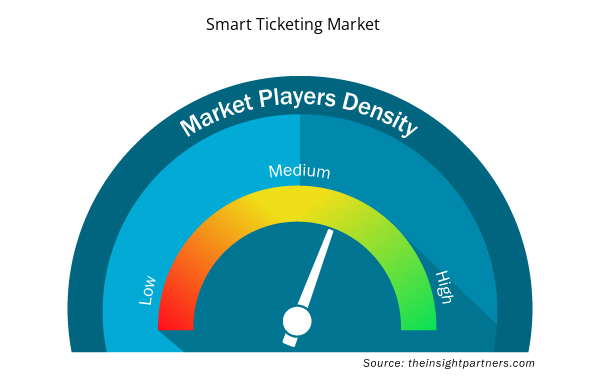智能票务市场规模预计将从 2023 年的 68.5 亿美元增至 2031 年的 165.1 亿美元。预计 2023-2031 年期间市场复合年增长率将达到 11.6 %。智能票务中的区块链技术可能会为市场带来新的趋势。
智能票务市场分析
近年来,智能票务市场取得了显着增长。各行业快速数字化等因素导致对非接触式支付的依赖性日益增加。此外,全球越来越多地采用智能设备预订门票,预计将促进智能票务市场规模的增长。此外,人工智能、虚拟现实地图、智能手机和可穿戴设备等先进技术在票务系统中的集成预计将在未来几年带来新的智能票务市场趋势。
智能票务市场概况
将旅行票以电子方式存储在微芯片(通常放在智能卡上)上的过程称为智能票务。使用ITSO 智能卡将消除使用现金和纸质票的传统支付方式的需求,从而使公共交通用户能够轻松上下公交车、电车或火车。为了授权行程,交通运营商使用静态售票机或手持售票机在检票处扫描非接触式智能卡。随着人们越来越重视数字化售票流程,智能票作为传统纸质票务的现代替代品,已经获得了巨大的吸引力。这项创新技术通过消除排队购票的需要,节省了乘客的时间。它还发展到涵盖智能卡和移动应用程序,为纸质票提供了更好的替代方案。此外,智能票务广泛应用于各种交通方式,并在体育和娱乐活动中的应用越来越多。一个著名的例子是里约热内卢, 它举办了奥运会,预计将有 50 万国际游客。该市的公共交通票务系统采用了金雅拓的 非接触式技术,包括防水的“ Celego非接触式腕带”和“ Celego非接触式贴纸”,均嵌入了金雅拓的非接触式芯片,并经过 Visa 和万事达卡认证。只需将腕带靠近非接触式读卡器轻轻一挥,即可激活这些解决方案,这代表着在全球范围内引入的一项重大基础设施增强。
定制此报告以满足您的需求
您可以免费定制任何报告,包括本报告的部分内容、国家级分析、Excel 数据包,以及为初创企业和大学提供优惠和折扣
- 获取此报告的关键市场趋势。这个免费样品将包括数据分析,从市场趋势到估计和预测。
智能票务市场驱动因素和机遇
公共交通数字支付需求不断增长
现代城市提供各种交通选择,例如公共汽车、火车和地铁。每个公共交通系统都有自己的票务系统。管理不同交通方式的多张智能卡或应用程序可能会让通勤者感到不知所措。需要一种集中式方法来整合所有交通网络。朝着这个方向,世界各地的公共交通基础设施正在升级。升级还旨在通过无缝支付界面改善通勤体验。例如,2023 年 5 月,全球智能移动技术解决方案提供商、Conduent Incorporated(纳斯达克股票代码:CNDT )的业务部门Conduent Transportation宣布,其子公司(Conduent和Convergint的合资企业)已被维多利亚州(澳大利亚)选中,为该州提供下一代公共交通票务系统,即myki。两家公司旨在实施一种先进的、基于非接触式支付账户的交通票务系统,该系统将升级该州当前的智能卡解决方案,并为乘客提供更好的用户体验。 2022 年 12 月,日立铁路的 360Pass 旅行平台在特伦蒂诺(意大利)上线,允许客户乘坐城市中的所有公共交通工具,而无需购买传统车票。该应用程序可从任何应用商店免费获取。市民和游客下载该应用程序后,可以使用智能手机轻松购买多式联运票。随着城市发展成为智能、互联和数字优先的环境,公共交通服务的数字支付将继续成为议程的重中之重,从而推动智能票务市场的增长。
智能体育场的投资不断增加
近年来,全球对非接触式体验系统的需求加速了智能票务在体育场和活动销售流程中的使用。智能票务为体育场和活动组织者提供了一种更高效运营的简便方法,避免了间接成本和程序瓶颈。这一点至关重要,因为传统的纸质票务需要更多的劳动力和资源,使其成为一种不可持续的组织体育赛事的方法。实施智能票务系统可以大大提高门票销售量,让球迷可以查看自己喜欢的座位是否有空位,并订购符合自己喜好的门票。从这些预订中获得的重要数据使组织者能够确定球迷最感兴趣的领域,从而制定吸引特定受众群体的有针对性的票务策略。通过智能票务负责票务验证,体育场工作人员可能会被重新分配,以改善球迷体验、协助人群管理、提供信息和指导,或支持需要人工干预的关键领域。智能票务通过简化票务操作,最大限度地利用工人,提高运营效率和观众的整个体育场体验。例如,在 2013 年国际足联联合会杯、2014 年国际足联世界杯、2017 年国际足联联合会杯、2018 年国际足联世界杯、2021 年国际足联阿拉伯杯和 2022 年卡塔尔国际足联世界杯期间,数百万支持者使用了 RFID 门票。国际足联已任命 HID 为其官方票务生产商。因此,增加对智能体育场的投资以使用户支付体验无缝衔接,预计将为智能票务市场扩张创造丰厚的机会。
智能票务市场报告细分分析
有助于智能票务市场分析的关键部分是组件、支付系统和最终用户。
- 根据组件,市场分为硬件、软件和服务。硬件部分在 2023 年占据了最大的市场份额。
- 根据支付系统,市场分为开放支付系统、智能卡和 NFC。智能卡领域在 2023 年占据了最大的市场份额。
- 就最终用户而言,市场分为交通、体育和娱乐、停车和其他。2023 年,体育和娱乐领域占据了市场主导地位。
智能票务市场份额(按地区)分析
智能票务市场报告的地理范围主要分为五个地区:北美、亚太、欧洲、中东和非洲、南美和中美。
2023 年,北美占据了相当大的市场份额。由于智能票务系统中使用的智能卡技术的进步,北美智能票务市场正在经历显着增长。智能手机和尖端可穿戴设备推动的非接触式解决方案正在获得显着的关注,因为这些解决方案有助于优化时间并通过灵活的支付方式减少实体售票柜台的摩擦。三星等知名智能可穿戴设备制造商已在其智能手表中引入了支付功能。此外,大多数设备制造商都在将支付服务(包括三星支付、Fitbit Pay、Apple Pay、Garmin Pay 和 Google Pay)集成到他们的移动钱包产品中。虽然智能手表支付仍处于发展阶段,但它们具有巨大的市场潜力。这些发展预计将使消费者能够使用他们的可穿戴设备购买门票,这反映了票务格局的显着转变。此外,Cubic Corporation 等主要智能票务市场参与者采取的举措对市场有利。
例如,2023 年 5 月,英飞凌的 CALYPSO 举措促进了符合开放标准的可互操作票务解决方案的开发,使制造商能够根据交通运营商和当局的独特需求量身定制解决方案。这种方法消除了对磁条、条形码和专有票证的依赖,确保了跨不同系统的更大灵活性和兼容性。这一发展代表着全州非接触式票务系统的现代化和扩展迈出了重要一步,计划在整个客运铁路系统全面部署,随后是公交车和渡轮。
智能票务市场区域洞察
Insight Partners 的分析师已详尽解释了预测期内影响智能票务市场的区域趋势和因素。本节还讨论了北美、欧洲、亚太地区、中东和非洲以及南美和中美洲的智能票务市场细分和地理位置。

- 获取智能票务市场的区域特定数据
智能票务市场报告范围
| 报告属性 | 细节 |
|---|---|
| 2023 年的市场规模 | 68.5亿美元 |
| 2031 年市场规模 | 165.1亿美元 |
| 全球复合年增长率(2023 - 2031) | 11.6% |
| 史料 | 2021-2022 |
| 预测期 | 2024-2031 |
| 涵盖的领域 | 按组件
|
| 覆盖地区和国家 | 北美
|
| 市场领导者和主要公司简介 |
|
市场参与者密度:了解其对商业动态的影响
智能票务市场正在快速增长,这得益于终端用户需求的不断增长,而这些需求又源于消费者偏好的不断变化、技术进步以及对产品优势的认识不断提高等因素。随着需求的增加,企业正在扩大其产品范围,进行创新以满足消费者的需求,并利用新兴趋势,从而进一步推动市场增长。
市场参与者密度是指在特定市场或行业内运营的企业或公司的分布情况。它表明在给定市场空间中,相对于其规模或总市场价值,有多少竞争对手(市场参与者)存在。
在智能票务市场运营的主要公司有:
- 英飞凌科技股份公司
- 恩智浦半导体
- 施乐公司
- 立方公司
- 艾迪米
- HID全球公司 (ASSA ABLOY)
免责声明:上面列出的公司没有按照任何特定顺序排列。

- 获取智能票务市场顶级关键参与者的概述
智能票务市场新闻和最新发展
智能票务市场通过收集一手和二手研究后的定性和定量数据进行评估,其中包括重要的公司出版物、协会数据和数据库。智能票务市场的一些发展如下:
- 英飞凌的 CALYPSO 举措促进了符合开放标准的可互操作票务解决方案的开发,使制造商能够根据交通运营商和当局的独特需求量身定制解决方案。这种方法消除了对磁条、条形码和专有票证的依赖,确保了跨不同系统的更大灵活性和兼容性。(来源:英飞凌,新闻稿,2023 年 5 月)
- NXP 半导体公司推出了其 MIFARE Ultralight 系列的最新产品,被誉为最安全的变体。MIFARE Ultralight AES 利用标准 AES 身份验证,并拥有通用标准 EAL3+ 安全认证,为有限使用的非接触式票证、RFID 基本宾客卡和类似应用提供增强的隐私和安全性。(来源:NXP 半导体公司,新闻稿,2022 年 2 月)
智能票务市场报告覆盖范围和交付成果
“智能票务市场规模和预测(2021-2031)”报告对以下领域进行了详细的市场分析:
- 智能票务市场规模及全球、区域和国家层面所有主要细分市场的预测
- 智能票务市场趋势以及驱动因素、限制因素和关键机遇等市场动态
- 详细的 PEST 和 SWOT 分析
- 智能票务市场分析涵盖主要市场趋势、全球和区域框架、主要参与者、法规和最新市场发展
- 行业格局和竞争分析,涵盖市场集中度、热点图分析、知名参与者以及智能票务市场的最新发展
- 详细的公司简介
- 历史分析(2 年)、基准年、预测(7 年)及复合年增长率
- PEST 和 SWOT 分析
- 市场规模价值/数量 - 全球、区域、国家
- 行业和竞争格局
- Excel 数据集


- Small Internal Combustion Engine Market
- Industrial Inkjet Printers Market
- Underwater Connector Market
- Lyophilization Services for Biopharmaceuticals Market
- Oxy-fuel Combustion Technology Market
- Vision Guided Robotics Software Market
- Nuclear Decommissioning Services Market
- Occupational Health Market
- Clinical Trial Supplies Market
- Authentication and Brand Protection Market

Report Coverage
Revenue forecast, Company Analysis, Industry landscape, Growth factors, and Trends

Segment Covered
This text is related
to segments covered.

Regional Scope
North America, Europe, Asia Pacific, Middle East & Africa, South & Central America

Country Scope
This text is related
to country scope.
常见问题
Increasing demand for smart ticketing from sport, entertainment, and tourism sectors are driving the smart ticketing market.
The smart ticketing market was estimated to be valued at US$ 6.85 billion in 2023 and is projected to reach US$ 16.51 billion by 2031; it is anticipated to grow at a CAGR of 11.6% over the forecast period.
The hardware segment led the microprocessors market with a significant share in 2023.
The smart ticketing market is expected to reach US$ 16.51 billion by 2031.
Asia Pacific is anticipated to grow at the fastest CAGR over the forecast period.
The usage of blockchain in smart ticketing industry are expected to drive the growth of the smart ticketing market in the coming years.
The key players holding majority shares in the smart ticketing market include Infineon Technologies AG, NXP Semiconductors, Xerox Corporation, Cubic Corporation, and IDEMIA.
Trends and growth analysis reports related to Electronics and Semiconductor : READ MORE..
The List of Companies - Smart Ticketing Market
Infineon Technologies AG
NXP Semiconductors
Xerox Corporation
Cubic Corporation
IDEMIA
HID Global Corporation (ASSA ABLOY)
CPI Card Group Inc.
Confidex Ltd.
Thales Group
Giesecke & Devrient GmbH
The Insight Partners performs research in 4 major stages: Data Collection & Secondary Research, Primary Research, Data Analysis and Data Triangulation & Final Review.
- Data Collection and Secondary Research:
As a market research and consulting firm operating from a decade, we have published and advised several client across the globe. First step for any study will start with an assessment of currently available data and insights from existing reports. Further, historical and current market information is collected from Investor Presentations, Annual Reports, SEC Filings, etc., and other information related to company’s performance and market positioning are gathered from Paid Databases (Factiva, Hoovers, and Reuters) and various other publications available in public domain.
Several associations trade associates, technical forums, institutes, societies and organization are accessed to gain technical as well as market related insights through their publications such as research papers, blogs and press releases related to the studies are referred to get cues about the market. Further, white papers, journals, magazines, and other news articles published in last 3 years are scrutinized and analyzed to understand the current market trends.
- Primary Research:
The primarily interview analysis comprise of data obtained from industry participants interview and answers to survey questions gathered by in-house primary team.
For primary research, interviews are conducted with industry experts/CEOs/Marketing Managers/VPs/Subject Matter Experts from both demand and supply side to get a 360-degree view of the market. The primary team conducts several interviews based on the complexity of the markets to understand the various market trends and dynamics which makes research more credible and precise.
A typical research interview fulfils the following functions:
- Provides first-hand information on the market size, market trends, growth trends, competitive landscape, and outlook
- Validates and strengthens in-house secondary research findings
- Develops the analysis team’s expertise and market understanding
Primary research involves email interactions and telephone interviews for each market, category, segment, and sub-segment across geographies. The participants who typically take part in such a process include, but are not limited to:
- Industry participants: VPs, business development managers, market intelligence managers and national sales managers
- Outside experts: Valuation experts, research analysts and key opinion leaders specializing in the electronics and semiconductor industry.
Below is the breakup of our primary respondents by company, designation, and region:

Once we receive the confirmation from primary research sources or primary respondents, we finalize the base year market estimation and forecast the data as per the macroeconomic and microeconomic factors assessed during data collection.
- Data Analysis:
Once data is validated through both secondary as well as primary respondents, we finalize the market estimations by hypothesis formulation and factor analysis at regional and country level.
- Macro-Economic Factor Analysis:
We analyse macroeconomic indicators such the gross domestic product (GDP), increase in the demand for goods and services across industries, technological advancement, regional economic growth, governmental policies, the influence of COVID-19, PEST analysis, and other aspects. This analysis aids in setting benchmarks for various nations/regions and approximating market splits. Additionally, the general trend of the aforementioned components aid in determining the market's development possibilities.
- Country Level Data:
Various factors that are especially aligned to the country are taken into account to determine the market size for a certain area and country, including the presence of vendors, such as headquarters and offices, the country's GDP, demand patterns, and industry growth. To comprehend the market dynamics for the nation, a number of growth variables, inhibitors, application areas, and current market trends are researched. The aforementioned elements aid in determining the country's overall market's growth potential.
- Company Profile:
The “Table of Contents” is formulated by listing and analyzing more than 25 - 30 companies operating in the market ecosystem across geographies. However, we profile only 10 companies as a standard practice in our syndicate reports. These 10 companies comprise leading, emerging, and regional players. Nonetheless, our analysis is not restricted to the 10 listed companies, we also analyze other companies present in the market to develop a holistic view and understand the prevailing trends. The “Company Profiles” section in the report covers key facts, business description, products & services, financial information, SWOT analysis, and key developments. The financial information presented is extracted from the annual reports and official documents of the publicly listed companies. Upon collecting the information for the sections of respective companies, we verify them via various primary sources and then compile the data in respective company profiles. The company level information helps us in deriving the base number as well as in forecasting the market size.
- Developing Base Number:
Aggregation of sales statistics (2020-2022) and macro-economic factor, and other secondary and primary research insights are utilized to arrive at base number and related market shares for 2022. The data gaps are identified in this step and relevant market data is analyzed, collected from paid primary interviews or databases. On finalizing the base year market size, forecasts are developed on the basis of macro-economic, industry and market growth factors and company level analysis.
- Data Triangulation and Final Review:
The market findings and base year market size calculations are validated from supply as well as demand side. Demand side validations are based on macro-economic factor analysis and benchmarks for respective regions and countries. In case of supply side validations, revenues of major companies are estimated (in case not available) based on industry benchmark, approximate number of employees, product portfolio, and primary interviews revenues are gathered. Further revenue from target product/service segment is assessed to avoid overshooting of market statistics. In case of heavy deviations between supply and demand side values, all thes steps are repeated to achieve synchronization.
We follow an iterative model, wherein we share our research findings with Subject Matter Experts (SME’s) and Key Opinion Leaders (KOLs) until consensus view of the market is not formulated – this model negates any drastic deviation in the opinions of experts. Only validated and universally acceptable research findings are quoted in our reports.
We have important check points that we use to validate our research findings – which we call – data triangulation, where we validate the information, we generate from secondary sources with primary interviews and then we re-validate with our internal data bases and Subject matter experts. This comprehensive model enables us to deliver high quality, reliable data in shortest possible time.


 获取此报告的免费样本
获取此报告的免费样本